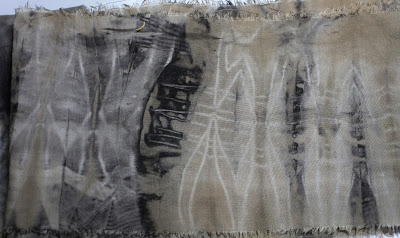I've been wondering about the next year's project, which would be some kind of cloth for the year of the Horse, if I decided to proceed along in this pattern of having a year's theme. I like this idea, mostly because looking ahead for years and years of projects is somehow cheering; it makes me chuckle. But I don't know what to make of a horse; dragons and snakes already had places in my imagination, but horses don't seem to. Except for the windhorse, which I think of as always a vessel for hope, good wishes and good fortune.
But how to represent 'good fortune', as something you hope for others and that falls upon you unbidden? It struck me this morning, after many morning walks with the dog wondering, that the answer was that cloth, itself, is for me this good fortune. A found cloth is like a blessing for me, good fortune, a bit of good luck, a spur to think and hope. And so are these, two damask table cloths dropped on my porch Christmas morning in a bag, along with a pound of home made cookies. A gift from a neighbour.
.jpg)
And so one of these cloths is where I'm going to start on my Year of the Horse cloth, a cloth about celebrating the good fortune of finding cloth, the good fortune of having a neighbour who walks her dog down here to drop off cookies and cloth, the good fortune I wish for this kind of place where we live.
And this is the finished little altar cloth I made to commemorate the good will of the bird rescue I wrote about earlier this summer. I guess I was starting on the same path, celebrating good fortune, and so this 2014 cloth will continue that thinking.
.jpg)
.jpg)
.jpg)











.jpg)

.jpg)
.jpg)
.jpg)

.jpg)









.jpg)

















